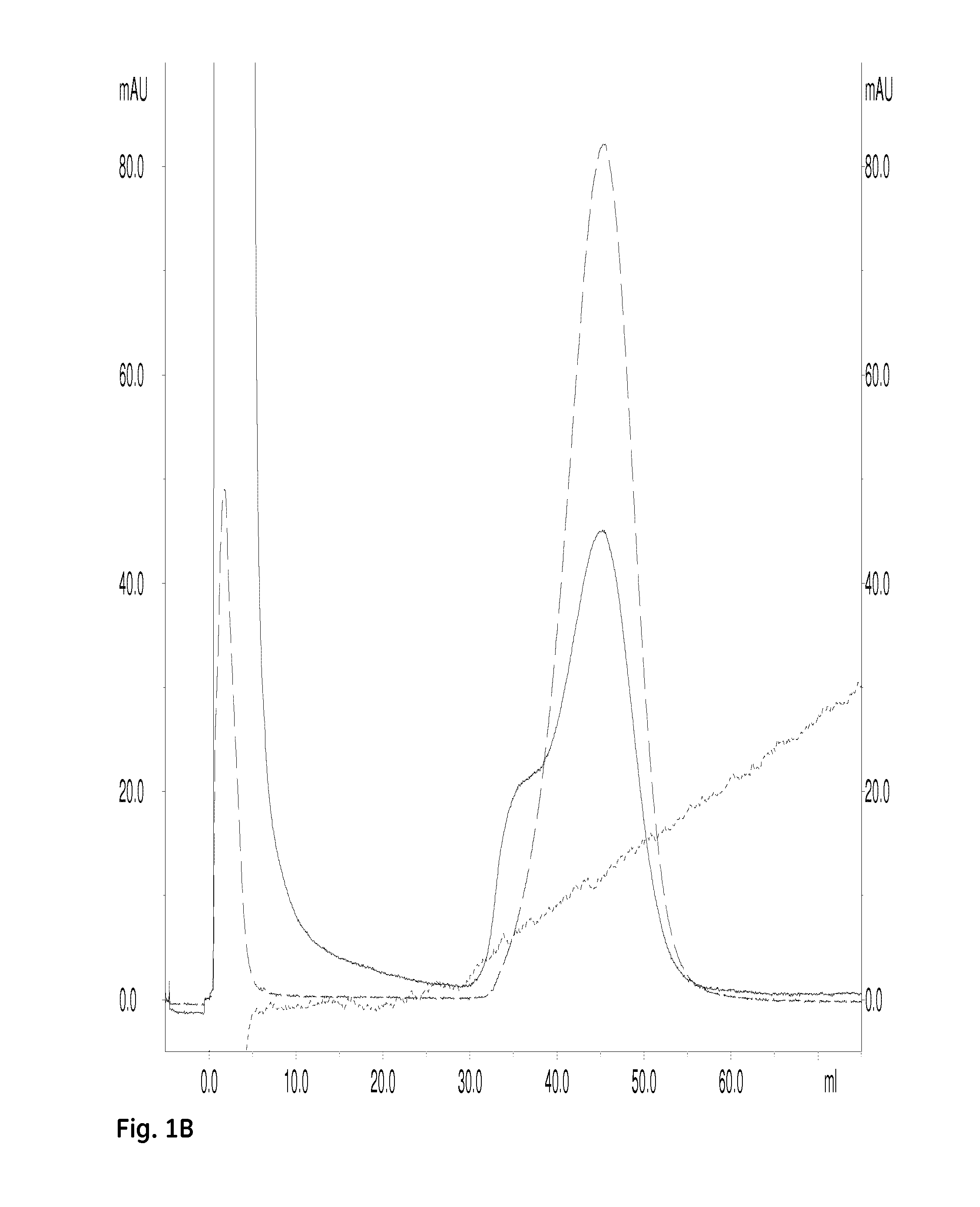Novel chelator and use thereof
a chelator and dimeric technology, applied in the field of biomolecule purification, detection, binding and/or immobilization, can solve the problems of not finding any prior art describing pentadentate dimeric chelators in general, and achieve the effects of increasing affinity, increasing binding specificity for histidine-tagged proteins, and increasing affinity
- Summary
- Abstract
- Description
- Claims
- Application Information
AI Technical Summary
Benefits of technology
Problems solved by technology
Method used
Image
Examples
example 1
Synthesis, Coupling and Characterization of a Dimeric Pentadentate Chelator (1)
[0087]
[0088]The synthetic route for the pentadentate dimer prototype (1) is described below.
Synthesis of the Tetraethyl EDTA Ester (4)
[0089]All glassware was dried before use. A 500 ml two-necked round bottomed flask was connected to a water cooler and sealed. 5.0 g (17 mmol) Ethylenediaminetetraacetic acid (3) was added to the flask and dissolved in 200 ml dry ethanol. The flask was flushed with argon and resealed. 3.2 ml (63 mmol) concentrated Sulfuric acid was added to the slurry in one portion. The reaction was refluxed for 17 hours at 90° C. under argon atmosphere. The reaction was monitored by LC-MS (3-100% Acetonitrile (0.05% TFA) in MilliQ water (0.05% TFA), 10 min, 0.5 ml / min, YMC-Pack Hydrosphere C18, S-3 μm, 120 Å, 50×4.6 mm i.d.).
[0090]150 ml water was added followed by solid Sodium hydrogen carbonate to pH 9. Ethanol was removed by vacuum and the aqueous solution was extracted with 150 ml Chl...
example 2
Synthesis, Coupling and Characterization of a Dimeric Pentadentate Chelator (2)
[0114]
[0115]The synthetic route for the pentadentate dimer prototype (2) is described below.
Synthesis of 6-Ethyl Carbamoylsulfanyl-Hexanoic Acid (9)
[0116]3.4 ml dry Dimethylformamide was added to a capped round bottomed flask under Nitrogen atmosphere. 294 μl (3.4 mmol) of 3-Mercaptohexanoic acid (8) was added in one portion via syringe. The solution was cooled to −20° C. 294 μl (3.7 mmol) of Ethylisocyanate was added drop-wise and the reaction mixture was left to react at room temperature for 18 hrs. The reaction was monitored by TLC. 0.5 g Ce(IV)(SO4)2 and 2.5 g (NH4)6Mo7O24 in 5 ml Sulfuric acid and 45 ml deionized water was used as dyeing agent.
[0117]The solvent was removed by vacuum, triturated with ether to give white crystals. The crystals were dried, affording white crystals.
[0118]TLC (20:1.5 Dichloromethane:Methanol, 0.5% TFA): Rf=0.30
Synthesis of Fully Protected Pentadentate Dimer (13)
[0119]The ...
example 3
Biacore Determination of Affinities for Binding of a Hexahistidine Peptide to Ni2+-Charged Immobilized Pentadentate Chelators, Dimeric and Monomeric
[0132]The dimeric pentadentate ligand from Example 1 was dissolved to 30 mM in 0.1 M NaOH; the corresponding monomeric pentadentate ligand was dissolved to 30 mM in 0.1 M NaOH.
[0133]Other materials (from GE Healthcare):
[0134]Sensor Chip CM5, BR-1000-14.
[0135]Biacore 2000 instrument
[0136]Amine Coupling Kit with EDC and NHS, BR-1000-50.
[0137]2-(2-pyridinyldithio)ethaneamine hydrochloride (PDEA), BR-1000-58.
[0138]HBS-P buffer: 10 mM HEPES pH 7.4, 0.15 M NaCl, 0.005% v / v Surfactant P20, BR-1003-68.
[0139]A nickel ion charging and recharging solution was prepared: 10 mM HEPES pH 7.4, 0.15 M NaCl, 0.005% v / v Surfactant P20, 500 μM NiSO4.
[0140]Regeneration solution consisted of 10 mM HEPES, 0.15 M NaCl, 0.005% surfactant, and 100 mM imidazole, pH 7.4.
[0141]A 500 mM solution of the hexa-peptide “hex-his” (consisting of six histidines coupled to e...
PUM
| Property | Measurement | Unit |
|---|---|---|
| pH | aaaaa | aaaaa |
| pH | aaaaa | aaaaa |
| pH | aaaaa | aaaaa |
Abstract
Description
Claims
Application Information
 Login to View More
Login to View More - R&D
- Intellectual Property
- Life Sciences
- Materials
- Tech Scout
- Unparalleled Data Quality
- Higher Quality Content
- 60% Fewer Hallucinations
Browse by: Latest US Patents, China's latest patents, Technical Efficacy Thesaurus, Application Domain, Technology Topic, Popular Technical Reports.
© 2025 PatSnap. All rights reserved.Legal|Privacy policy|Modern Slavery Act Transparency Statement|Sitemap|About US| Contact US: help@patsnap.com



